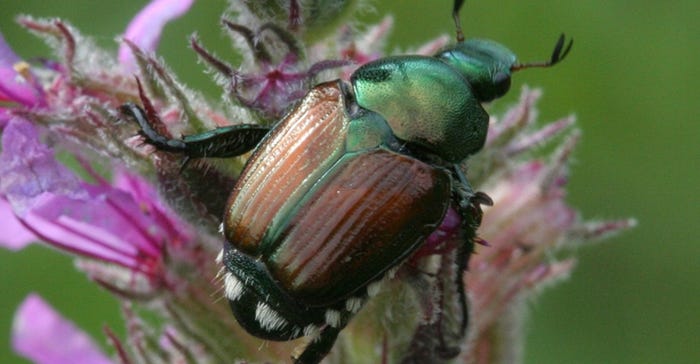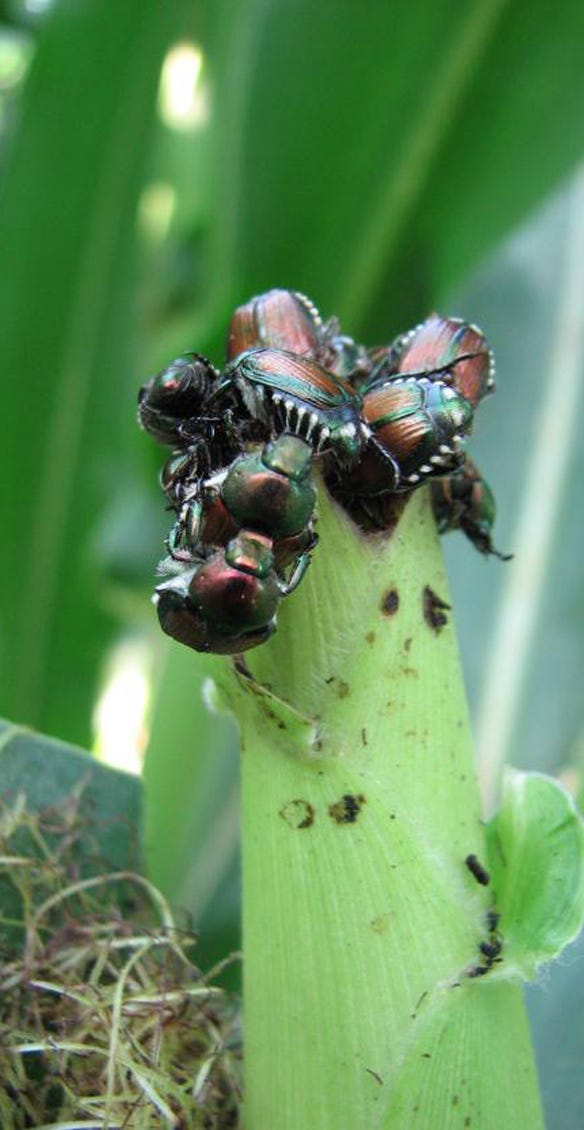
Iowa farmers and crop scouts have reported seeing insects in soybean fields the past week or two. The pests are Japanese beetles and thistle caterpillars.
Japanese beetle is an invasive insect capable of feeding on corn and soybean, says Erin Hodgson, Iowa State University Extension entomologist. “This pest has been in Iowa since 1994, but its distribution in field crops is sporadic around the state,” she says. “Statewide populations have been low since 2014, and it is unclear if pressure will be significant this year. Japanese beetle adults need about 1,030 growing degree days (base 50 degrees F) to complete development and will continue emergence until around 2,150 degree days.”
 JAPANESE BEETLE: The adults are metallic bronze and green with white tufts along the side of the abdomen.
JAPANESE BEETLE: The adults are metallic bronze and green with white tufts along the side of the abdomen.

Based on accumulating degree day temperatures in 2017, Japanese beetle adults began showing activity in some areas of southern Iowa the week of June 13. Hodgson provides the following information and recommendations to keep in mind regarding management of Japanese beetle.
1 insect generation per year in Iowa
First, understand the life cycle. Japanese beetles have one generation per year in Iowa. Adults emerge from grass in late June and immediately begin to feed on low-lying plants, such as roses and shrubs. Adults eventually move up on trees and field crop foliage to feed and mate. Mated females move back to grass areas in August and September to lay small egg masses in soil cavities.
The eggs hatch into small grubs that feed on roots underground until late September when the temperature cools. The almost fully grown grubs burrow down in the soil and remain inactive all winter. In the early spring, grubs become active again and feed until turning into resting pupae. The pupae hatch into adults and emerge from the soil.
Diagnosing plant injury
Japanese beetles have a wide host range that includes many species of fruit and vegetable crops, ornamentals, and field crops. On soybeans, adults prefer to feed between the leaf veins and can ultimately consume most of the leaf. The treatment threshold for Japanese beetle in soybean is 30% defoliation before bloom and 20% defoliation after bloom. Most people tend to overestimate plant defoliation.
In corn, Japanese beetles can feed on leaves, but the most significant injury comes from clipping silks during pollination. Consider applying a foliar insecticide during tasseling and silking if:
• There are three or more beetles per ear.
• Silks have been clipped to less than a half inch.
• Pollination is less than 50% complete.
 CLIPPING CORN SILKS: Japanese beetles are strongly attracted to silking corn and can clip silks.
CLIPPING CORN SILKS: Japanese beetles are strongly attracted to silking corn and can clip silks.

Thistle caterpillars also in soybean fields
On June 21 while scouting a commercial field north of Ames, ISU entomologist Erin Hodgson was looking for soybean aphid. “I didn't see one aphid, but I did see a handful of thistle caterpillars,” she says. “The caterpillars web together the soybean leaves and feed inside the temporary home. They also produce copious amounts of dark brown frass pellets inside the webbed leaves.”
Thistle caterpillars are most commonly seen in the early vegetative stages of soybean growth but rarely build up to economic populations. Read more about thistle caterpillars in this ICM Article.
“People don't like to see defoliators in field crops, but do like to see butterflies,” says Hodgson. “In this case, the thistle caterpillar will turn into the painted lady butterfly.”
About the Author(s)
You May Also Like




